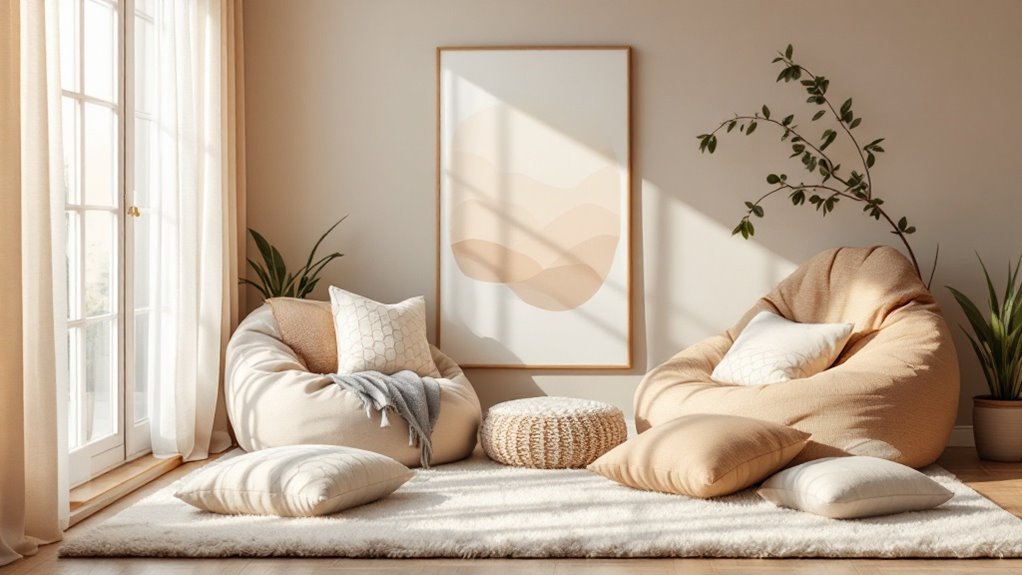It's interesting how you stumbled upon this topic just as someone else shared their struggle with sensory overload at home. Creating a sensory-friendly space isn't just about aesthetics; it's about understanding individual needs and crafting an environment that promotes calm and comfort. By evaluating specific preferences and making intentional choices regarding colors, textures, and lighting, you can transform your home into a sanctuary. But where do you even begin to identify those essential elements? Exploring the right strategies can make all the difference in enhancing well-being for everyone involved.
Essential Key Takeaways for Creating a Sensory-Friendly Home
- Assess sensory needs by tracking triggers and preferences to inform design choices that enhance comfort and reduce anxiety.
- Use calming colors like soft blues and greens, and incorporate soft textures to create a soothing atmosphere.
- Control lighting with warm bulbs and dimmable options, while minimizing harsh glare through sheer curtains.
- Create defined zones for relaxation, work, and play to establish boundaries and enhance focus.
- Include sensory tools like fidget toys, weighted blankets, and noise-canceling headphones to support diverse sensory needs.
Assess Sensory Needs
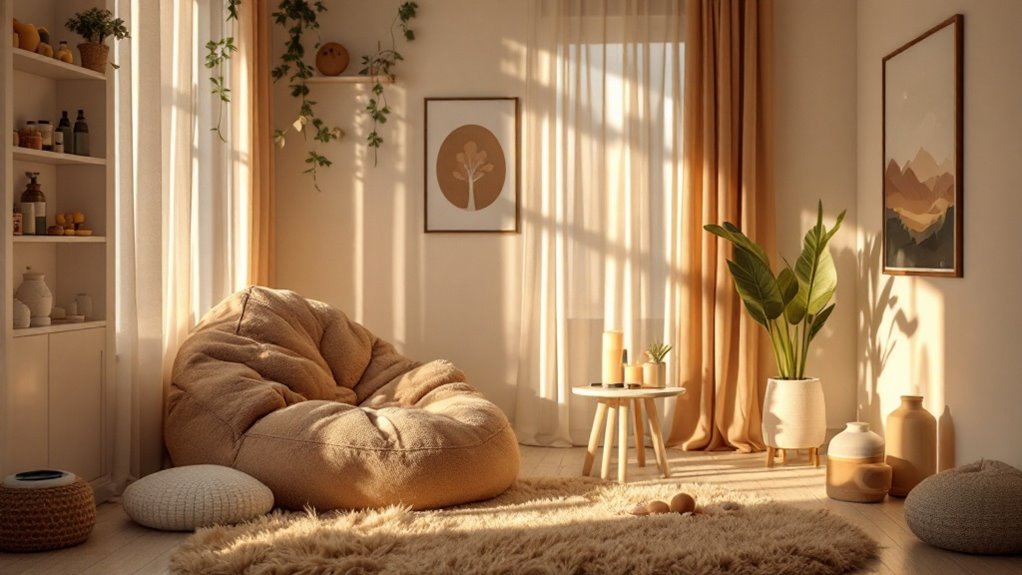
When setting out to create a sensory-friendly space at home, it's crucial to evaluate your sensory needs first. Start by identifying what sensory inputs you find calming or overwhelming. Pay attention to your reactions to different sounds, textures, lights, and smells. Keep a journal for a week, noting situations that trigger stress or discomfort. This'll help you pinpoint specific areas to address.
Next, consider the activities you enjoy and how they relate to your sensory preferences. Do you thrive in quiet environments, or do you need soft background noise? Think about your favorite materials—maybe you love the feel of plush fabrics or the sight of natural elements. These insights will guide you in curating your space effectively.
Don't forget to involve others who share your space. Discuss their sensory needs, too, as collaboration can create a more harmonious environment.
You'll find that understanding each person's preferences can lead to solutions that work for everyone. Ultimately, evaluating your sensory needs is the first step toward designing a space that fosters comfort and tranquility, allowing you to recharge and feel at ease in your home.
Choose Calming Colors
How do colors influence your mood and sense of calm? The colors in your environment can greatly affect how you feel. For a sensory-friendly space, choosing calming colors is essential. Soft blues and greens are often associated with tranquility and relaxation, making them ideal for bedrooms or meditation areas. These shades can remind you of nature, helping to reduce stress and promote a sense of peace.
You might also consider neutral tones like soft grays or beiges. These colors create a soothing backdrop that allows your mind to unwind. Avoid overly bright or bold colors that can be overstimulating and create anxiety. Instead, aim for muted tones to maintain a serene atmosphere.
When it comes to accents, gentle pastels can add warmth without overwhelming your senses. You could use light pinks, lavenders, or buttery yellows to introduce subtle hints of color that uplift your space.
Incorporate Soft Textures
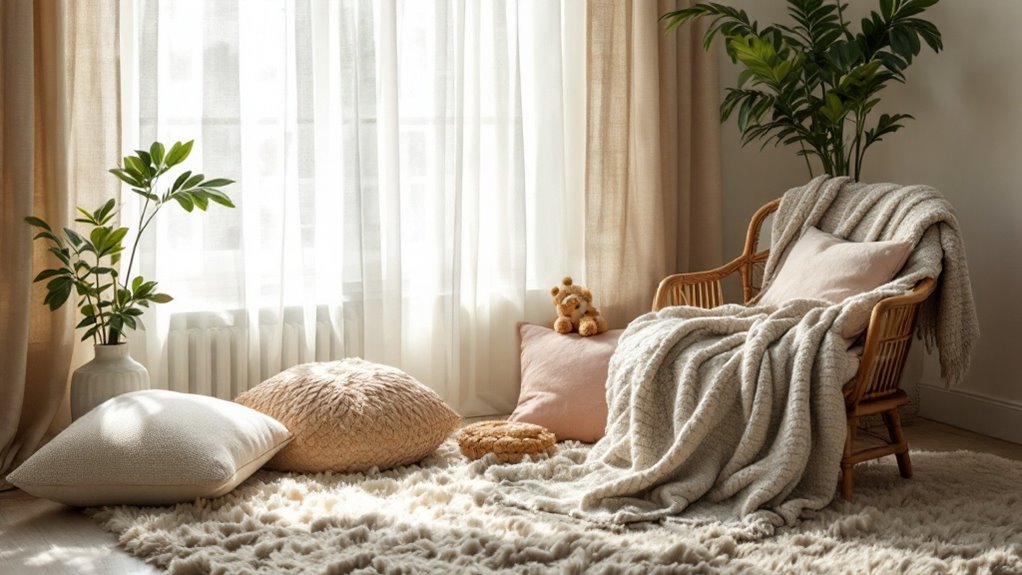
Soft textures can transform your sensory-friendly space into a haven of comfort. When you incorporate soft fabrics, you invite a sense of calm and security.
Think about layering plush blankets, fuzzy pillows, and soft rugs to create inviting areas where you can relax or unwind. These textures not only feel good against your skin but also provide a tactile experience that can soothe your senses.
Choose materials like cotton, fleece, or velvet for their inviting softness. You might even consider adding a variety of textures—like a knitted throw paired with a silky pillow—to create a more engaging sensory experience.
Don't forget about your seating options; upholstered furniture with soft cushions can make a significant difference in comfort levels.
Additionally, consider incorporating tactile toys or stress-relief items made from soft materials. These can help ground you during overwhelming moments.
Finally, pay attention to your bedding; soft sheets and comforters can drastically improve your sleep quality, making your space truly sensory-friendly.
Control Lighting Options
Lighting plays an essential role in creating a sensory-friendly space that feels welcoming and calming. You'll want to control the lighting options to minimize overstimulation and promote relaxation.
Start by evaluating the natural light in your home. Soft, diffused sunlight can be incredibly soothing, so consider using sheer curtains to filter harsh rays while still allowing warmth in.
Next, think about the types of artificial lighting you use. Instead of bright, fluorescent lights, opt for warmer, softer bulbs. Dimmable lights can be a fantastic choice, as they allow you to adjust the brightness based on your mood or activity.
Here are some tips for controlling your lighting options:
- Use lamps with adjustable brightness levels for flexibility in different settings.
- Incorporate string lights or LED strip lights for a cozy, ambient glow.
- Avoid harsh white lights; instead, choose warm or colored bulbs to create a more inviting atmosphere.
Create Designated Quiet Areas
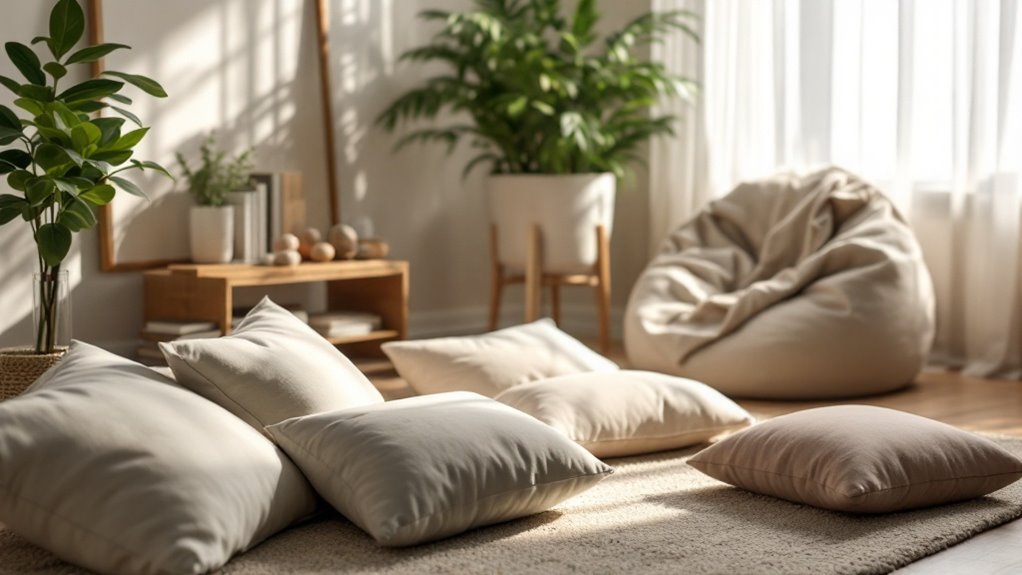
Creating a sensory-friendly environment goes beyond just managing lighting; it also involves carving out spaces where you can retreat and recharge. Designated quiet areas offer a sanctuary from the hustle and bustle of everyday life.
Start by identifying a corner or room in your home that can serve this purpose. It could be a cozy nook with a comfortable chair or even a small room with minimal distractions.
Next, personalize this space to enhance its calming effect. Use soft colors, plush furnishings, and items that bring you comfort, like blankets or pillows. Keep the area free from clutter to promote a sense of tranquility.
Make sure the space is easily accessible, so you can slip away whenever you need a break.
You might consider adding a few sensory items, such as fidget toys or calming visuals, but keep it simple to avoid overstimulation.
Finally, set clear boundaries with others in your home, letting them know when you need some quiet time.
Use Sound-Absorbing Materials
Sound-absorbing materials can transform your home into a more peaceful sanctuary. By minimizing echoes and reducing background noise, these materials help create a calming environment, perfect for relaxation and focus.
You can easily incorporate them into your space without major renovations.
Consider adding the following sound-absorbing elements:
- Area Rugs: They not only add warmth but also dampen sound, making rooms feel cozier and quieter.
- Acoustic Panels: These are designed specifically to absorb sound waves. You can find them in various colors and patterns, allowing you to enhance your decor while reducing noise.
- Heavy Curtains: Thick, heavy drapes can block outside noise and create a soft, soothing atmosphere within your home.
Add Sensory-Friendly Decor
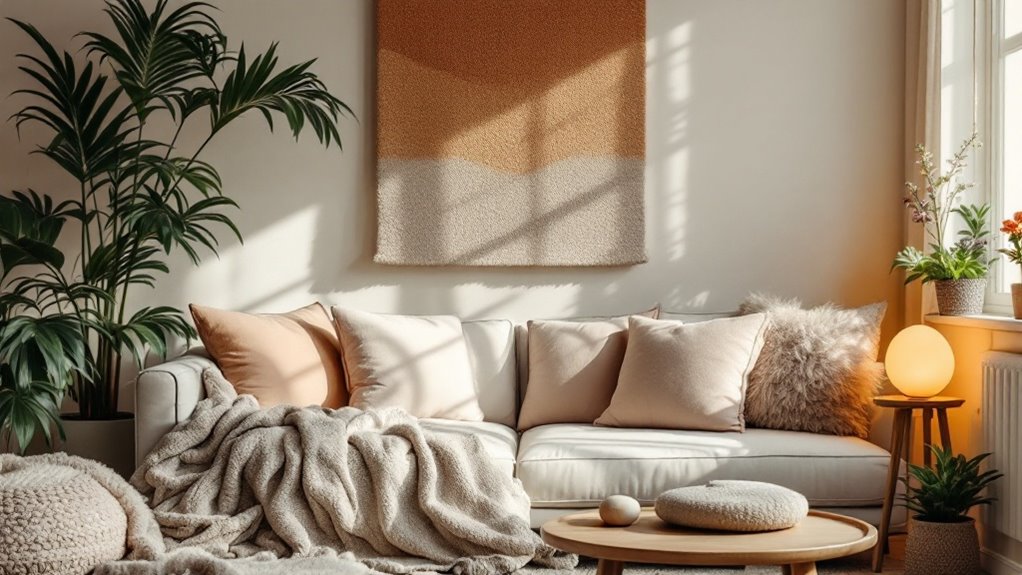
Decor can play an essential role in making your home more sensory-friendly. Start by choosing colors that soothe rather than overwhelm. Soft pastels or earthy tones can create a calming atmosphere, while bright colors might be too stimulating.
Incorporate textiles with varying textures, like plush rugs or soft curtains, to provide tactile comfort. Consider adding sensory-friendly elements such as bean bags or weighted blankets, which can offer a sense of security and relaxation.
You might also want to include visual elements like calming artwork or nature-inspired prints. These can help create a peaceful vibe in your space.
Lighting is another important aspect. Opt for soft, adjustable lighting options, like dimmers or string lights, to create a warm environment. Avoid harsh fluorescent lights, as they can be jarring.
Finally, include plants to bring life and tranquility into your home. They not only improve air quality but also provide a connection to nature, which can be incredibly grounding.
Maintain an Organized Space
An organized space can greatly enhance the sensory experience at home. When everything has its place, it reduces visual clutter, helping you feel more relaxed and focused.
You'll find it easier to engage with your sensory-friendly decor and enjoy the calming environment you've created.
To maintain this organized space, consider the following tips:
- Declutter regularly: Set aside time each week to remove items that no longer serve a purpose. This keeps your space tidy and manageable.
- Use storage solutions: Invest in baskets, bins, or shelves to store items out of sight. Labeling these can help you quickly find what you need without overwhelming your senses.
- Create zones: Designate specific areas for different activities, like reading, crafting, or relaxing. This not only keeps things organized but also helps you mentally prepare for what you're about to do.
Conclusion
Creating a sensory-friendly space at home can greatly improve comfort and well-being. Did you know that over 15% of the population experiences sensory processing issues? By evaluating your unique sensory needs and implementing calming colors, soft textures, and controlled lighting, you can design an environment that promotes relaxation and reduces anxiety. Remember, even small changes can make a big difference, so take the time to create a sanctuary that feels just right for you and your loved ones.

